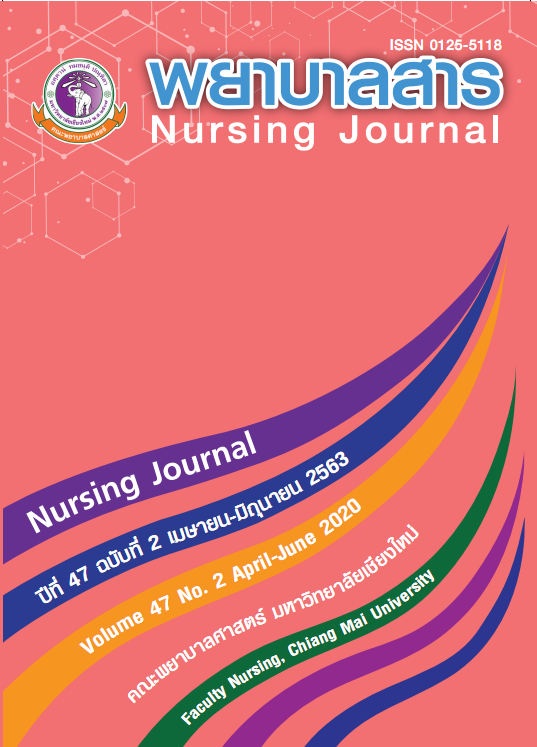Emotional Intelligence and Work-related Stress of Nurses in the People’s Hospitals of Dali, the People’s Republic of China
Keywords:
work-related stress, emotional intelligence, Nurse, People’s HospitalAbstract
An increased level of work-related stress can result in many negative problems in the healthcare system. Emotional intelligence is important for nurses to decrease their work-related stress. The purpose a of this descriptive correlation research were to explore the level of emotional intelligence and work-related stress, and to investigate the relationship between emotional intelligence and work-related stress of nurses in the People’s Hospitals of Dali, the People’s Republic of China. The samples included 273 nurses from two People’s Hospitals. The instrument used for data collection was a questionnaire including: Demographic Data Form, Wong and Law Emotional Intelligence Scale, and HSE Management Standards Work-related Stress Indicator Tool. The Cronbach’s alpha coefficient of Wong and Law Emotional Intelligence Scale was 0.91 and HSE Management Standards Work-related Stress Indicator Tool was 0.80. Data were analyzed using descriptive statistics and Spearman’s rank-order correlation.
The results of this study were as follows:
- The overall emotional intelligence of nurses was at a moderate level (= 4.55, SD = 1.44). Regarding each dimension, self-emotion appraisal was at a high level. Others’ emotion appraisal, regulation of emotion, and the use of emotion were at moderate levels.
- The overall work-related stress of nurses was at a moderate level (= 3.60, SD = 0.45). Regarding each dimension, five of the seven dimensions of work-related stress including demands, control, managerial support, relationships and change were at moderate level. The other two dimensions of peer support and role were at low levels.
- There was a weak negative correlation between nurses’ emotional intelligence and work-related stress (r = -0.13, p < 0.01).
Nurse administrators could use the results of this study as baseline information to develop and enhance emotional intelligence to help nurses reduce work-related stress.
References
Barnett, R. C., Brennan, R. T., & Gareis, K. C. (1999). A close r look at the measurement of burnout. Journal of Applied Biobehavioural Research, 4, 65-78.
Elkins, G., Cook, T., & Dove, J. (2010). Perceived stress among nurses and administration staff related accreditation. Clinical Nursing Research, 19 (4), 376-386.
Flanagan, N. A., & Flanagan, T. J. (2002). An analysis of the r elationship between job satisfaction and job stress in correctional nurses. Research in nursing & health, 25 (4), 282-294.
French, S., Lenton, R., Walters, V., & Eyles, J. (2000). An empirical evaluation of an expanded nursing stress scale. Journal of Nursing Measurement, 8 (2), 161-178.
Health and Safety Executive. (2004). Psychosocial working conditions in Great Britain in 2004. Retrieved from http:// www.hse.gov.uk/statistics/
Health and Safety Executive. (2009). Stress-related and psychological disorders. Retrieved from http://www.hse.gov.uk/statistics/causdis/stress.
Jenkins, R., & Elliot, P. (2004). Stressors, Burnout and social support: nurses in acute mental health settings. Journal of Advanced Nursing, 48 (6), 622-631.
Joiner, T. A., & Bartram, T. (2004). How empowerment and social support affect Australian nurses’ work stressors. Australian Health Review, 28 (1), 56-64.
Landa, J. A., L?pez-Zafra, E., & Martos, M. B. (2008). The relationship between emotional intelligence, occupational stress and health in nurses: A quest ionnaire survey. International Journal of Nursing Studies, 45 (6), 888-901.
Leka, S., Hassard, J., & Yanagida, A. (2012). Investigating the impact of psychosocial risks and occupational stress on psychiatric hospital nurses’ mental well-being in Japan. Journal of psychiatric and Menatal Health Nursing, 19, 123-131.
Li, I., Chen, Y. C., & Kuo, H. T. (2008). The relationship between work empowerment and work stress perceived by nurses at long term care facilities in Taipei city. Journal of Clinical Nursing, 17(22), 3050-3058.
Luo, Y. F. (2011). Conflict management and burnout among nurses in university hospi tals, Yunnan province, the People’s Republic of China (Master’s thesis, Chiangmai University).
Marinaccio, A., Ferrante, P., Corfiati, M., Di Tecco, C., Rondinone, B. M., Bonafede, M., & Iavicoli, S.(2013). The relevance of socio-demographic and occupational var iables for the assessment of work-related stress risk. BMC Public Health, 13, 11-57. doi:10.1186/1471-2458-13-1157.
Maslach, C., & Goldberg, J. (1998). Prevention of burnout: new perspectives. Applied and Preventative Psychology, 7, 63-74.
Ministry of Health of China. (2015). The health care organization statistic in China [in Chinese]. Beijing: the Ministry of Health of China.
Muchinsky, P. (2006). Psychology applied to work. Belmont, CA: Thompson Wadsworth.
Niezborala, M., Marquie, J. C., & Baracat, B. (2003). Job stress and occupational status in a French cohort. Rev Epidemiol Sante Publique, 6, 607-616.
Nikolaou, I., & Tsaousis, I. (2002). Emotional intelligence in the workplace: Exploring its effects on occupational stress and organizational commitment. International Journal of Organizational Analysis, 10 (4), 327-342.
Oginska-Bulik, N. (2005). Emotional intelligence in the workplace: Exploring its effects on occupational stress and health outcomes in human service workers. International Journal of Occupational Medicine and Environmental Health, 18(2), 167-175.
Palmer, S., Cooper, C., & Thomas, K. (2004). A model of work stress to underpin the Health and Safety Executive advice for tackling work-related stress and st ress risk assessments. Counselling at Work, Winter, 2-5.
Rauschenbach, C., & Hertel, G. 2011). Age differences in strain and emotional reactivity to stressors in professional careers. Stress Health, (27), 48-60.
Salovey, P., & Mayer, J. D. (1990). Emotional intelligence. Imagination, Cognition and Personality, 9(3), 185-211.
Wong, C. S., & Law, K. S. (2002). The effects of leader and follower emotional intelligence on performance and attitude: An exploratory study. Leadership Quarterly, 13, 243-274.
Yamani, N., Shahabi, M., & Haghani, F. (2014). The relationship between emotional intelligence and job stress in the faculty of medicine in Isfahan University of Medical Sciences. Journal of Advances in Medical Education and Professionalism, 2 (1), 20.
Yuan, X. (2007). The influence of “Nursing aesthetics” for emotional intelligen ce of bachelor degree students [in Chinese]. Shanxi: Shanxi Medical University.
Downloads
Published
How to Cite
Issue
Section
License
บทความที่ได้รับการตีพิมพ์เป็นลิขสิทธิ์ของวารสารพยาบาลสาร
ข้อความที่ปรากฏในบทความแต่ละเรื่องในวารสารวิชาการเล่มนี้เป็นความคิดเห็นส่วนตัวของผู้เขียนแต่ละท่านไม่เกี่ยวข้องกับมหาวิทยาลัยเชียงใหม่ และคณาจารย์ท่านอื่นๆในมหาวิทยาลัยฯ แต่อย่างใด ความรับผิดชอบองค์ประกอบทั้งหมดของบทความแต่ละเรื่องเป็นของผู้เขียนแต่ละท่าน หากมีความผิดพลาดใด ๆ ผู้เขียนแต่ละท่านจะรับผิดชอบบทความของตนเองแต่ผู้เดียว






